C图纸解密常用的方法
autocad图纸解密、炸开技巧

有的CAD图形由于加了密,整张图纸无法分解,这时候我们就不能对里面的构件进行转化,如果你用分解命令命令行会提示找到1个,1 个是多重插入引用,此时是无法分解的。这时候可能是由于CAD加密造成的,我们可以用CAD的UNLOCKDWG命令对图纸进行解密,解密后的图纸就能用分解等相关命令进行操作了。注:该命令需要加载插件lockdwg.VLX支持,可以从网上下载。
一、新建一个文档,将CAD内容通过复制,粘贴的方法保存。但这不是最好的方法。
二、输入save,保存即可。
3.在cad中,整体块能部分隐藏,块炸开后,原块全显示出来,是怎么做到的呢?怎样隐藏的?
使用“外部参照裁剪”命令,具体可以查看命令:xclip.
4.如何炸开“多重插入块”?提示“多重插入引用”.
(princ "\nOK,解密成功。")
(princ)
) Leabharlann 多重插入引用的分解(cad块的分解) 多重插入引用的分解
炸开“多重插入引用”的方法以及制作
1.“多重插入引用”的制作:用minsert命令,提示块名,在cad工作目录下找一张图,键入这个图名,然后到提示行数或列数时,输入2以上,但行距或列距输入0。这样一个多重插入引用制作完成,无法用explode炸开了。多重块不是重复定义块,而是在矩形阵列中插入一个块的多重引用。多重块是由命令minsert插入一个块而形成,其在正常情况下不能被分解。但若是用普通的方法构建的多重块,可以删除掉,然后用insert再插入它原来引用的块即可。不过,若它原来引用的块是匿名块(即名称前带*的块,只能用程序构建),就不是那么简单的了。这是,你就需要程序(或者说插件)来还原。vlx程序就是一个插件。也就是我上面说的编程实现。若不会编程,也没有插件,下面的方法四(方法三也可以实现)。
计算机应用如何进行计算机文件解密
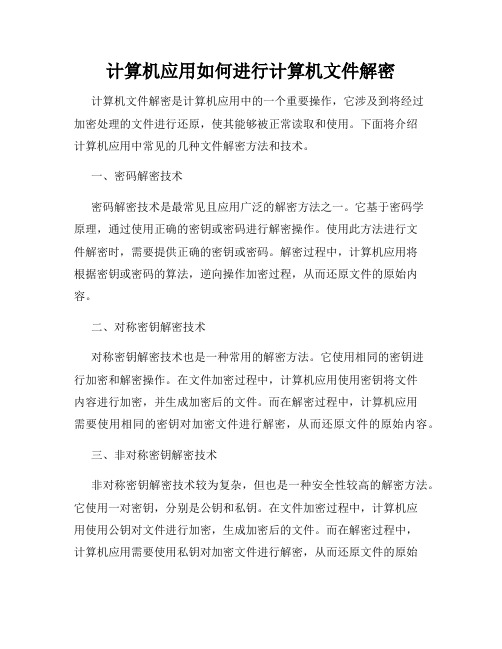
计算机应用如何进行计算机文件解密计算机文件解密是计算机应用中的一个重要操作,它涉及到将经过加密处理的文件进行还原,使其能够被正常读取和使用。
下面将介绍计算机应用中常见的几种文件解密方法和技术。
一、密码解密技术密码解密技术是最常见且应用广泛的解密方法之一。
它基于密码学原理,通过使用正确的密钥或密码进行解密操作。
使用此方法进行文件解密时,需要提供正确的密钥或密码。
解密过程中,计算机应用将根据密钥或密码的算法,逆向操作加密过程,从而还原文件的原始内容。
二、对称密钥解密技术对称密钥解密技术也是一种常用的解密方法。
它使用相同的密钥进行加密和解密操作。
在文件加密过程中,计算机应用使用密钥将文件内容进行加密,并生成加密后的文件。
而在解密过程中,计算机应用需要使用相同的密钥对加密文件进行解密,从而还原文件的原始内容。
三、非对称密钥解密技术非对称密钥解密技术较为复杂,但也是一种安全性较高的解密方法。
它使用一对密钥,分别是公钥和私钥。
在文件加密过程中,计算机应用使用公钥对文件进行加密,生成加密后的文件。
而在解密过程中,计算机应用需要使用私钥对加密文件进行解密,从而还原文件的原始内容。
由于私钥只有文件的拥有者可以访问,因此非对称密钥解密技术在保护文件安全方面具有较高的可靠性。
四、第三方解密工具除了上述基本的文件解密技术外,计算机应用还可以借助第三方解密工具进行文件解密操作。
第三方解密工具是由专门的软件开发人员开发的,具有丰富的解密算法和技术。
通过使用第三方解密工具,计算机应用可以更加方便地进行文件解密操作,同时提高解密的效率和准确性。
总结起来,计算机应用中的文件解密涉及密码解密技术、对称密钥解密技术、非对称密钥解密技术和第三方解密工具。
这些解密方法和技术能够满足不同加密程度的文件解密需求。
通过合理选择合适的解密方法和技术,计算机应用可以有效地进行文件解密操作,保证文件的安全性和可用性。
注意:本文仅讨论计算机应用中常见的文件解密方法和技术,并不涉及非法破解加密文件的行为。
CAD文件加密与解密

Cad文件加密软件:/CHN/index.asp?ID=UI6FA5SD4 5RY8E【SmartLock图纸锁】是坚固而实用的CAD图纸保护软件,可以有效保护您的设计图纸的知识产权,并帮助您提升其图纸价值。
可有效防止您的图纸文件被非法篡改或拷贝,使绘图文件能够安全分发给您的用户而无忧。
安装了一下,我的机器码:UI6FA5SD45RY8E,我的注册码:B430-20091121-4B56-5552-8C9D-CF4F-428E-3164。
结果是,完全没有用——因为可以另存!我晕,这算什么加密啊!然后看到这个:方法一:有两个好工具,可以轻松炸开。
一个是AutoCAD 快速加载AutoLISP 文件:wjjm;另一个cad加密插件,请大家使用。
具体方法:AutoCAD 快速加载AutoLISP 文件wjjm的使用:用cad打开需要炸开的文件,将wjjm直接拖入cad窗口,命令行输入wjmm,回车后按提示操作即可。
操作步骤:①于CAD中,选择:“工具”菜单→“加载应用程序”选项。
②于对话框中选择文件“wjjm”,进行应用程序加载。
③于CAD命令行中,输入“wjjm”命令,然后选择需要保护的图块,随便点击即可取消保护。
方法二:输入“CYN-”,将多重插入块转换为普通快,然后可以炸开编辑方法三:把以下内容保存为lsp文件(如exm.lsp),加载后运行exm既可把“多重插入块”转换为“普通块”,然后既可用“explode”分解。
加载后运行lockb可把“普通块”转换为“多重插入块”;;-------------------------------------------------------------;;转换“多重插入块”为“普通块”。
(DEFUN C:exm ()(setvar "cmdecho" 0)(SETQ STM (car (ENTSEL "\n点取多重块")))(while stm(setq e (entget stm))(setq stlx (cdr (assoc 0 e)))(if (= stlx "INSERT")(PROGN(setq r_zm70 (assoc 70 e))(setq c_zm71 (assoc 71 e))(setq r_dist_zm44 (assoc 44 e))(setq c_dist_zm45 (assoc 45 e))(setq e (subst (cons 44 0) r_dist_zm44 e))(setq e (subst (cons 45 0) c_dist_zm45 e))(setq e (subst (cons 70 0) r_zm70 e))(setq e (subst (cons 71 0) c_zm71 e))(setq e (subst (list 100"AcDbBlockReference") (list 100"AcDbMInsertBlock") e))(entmake e)(entdel stm)))(SETQ STM (car (ENTSEL "\n点取下一多重块"))))(setvar "cmdecho" 1));;-------------------------------------------------------------------- ;;转换“普通块”为“多重插入块”(DEFUN C:lockb ()(setvar "cmdecho" 0)(SETQ STM (car (ENTSEL "\n点取块")))(while stm(setq e (entget stm))(setq stlx (cdr (assoc 0 e)))(if (= stlx "INSERT")(PROGN(setq r_zm70 (assoc 70 e))(setq c_zm71 (assoc 71 e))(setq e (subst (cons 70 1) r_zm70 e))(setq e (subst (cons 71 1) c_zm71 e))(setq e (subst (list 100"AcDbMInsertBlock") (list 100"AcDbBlockReference") e))(entmake e)(entdel stm)))(SETQ STM (car (ENTSEL "\n点取下一块"))))(setvar "cmdecho" 1))在CAD工具菜单中加载应用exm.lsp,然后再输入exm命令,即可用“explode”分解。
C语言加密与解密常用的加密算法和协议

C语言加密与解密常用的加密算法和协议在计算机网络和信息安全领域,加密是一种广泛应用的技术,可以保护敏感数据的机密性和完整性。
C语言作为一种广泛使用的编程语言,提供了丰富的加密算法和协议的库函数,本文将介绍一些常用的加密算法和协议。
一、对称加密算法对称加密算法是指加密和解密使用相同密钥的算法,它的运算速度较快,适用于加密大量数据。
以下是几个常用的对称加密算法:1. DES(Data Encryption Standard)DES是一种基于对称密钥的加密算法,使用56位密钥进行加密和解密。
DES算法已经被证明在保护数据的机密性方面是有效的,但由于其较短的密钥长度,现在已经逐渐被更安全的算法取代。
2. AES(Advanced Encryption Standard)AES是一种高级加密标准算法,使用128、192或256位密钥进行加密和解密。
AES算法被广泛应用于各种领域,包括数据传输、硬盘加密和无线网络安全等。
它的安全性和性能都得到了广泛认可。
3. RC4(Rivest Cipher 4)RC4是一种流密码算法,它能够根据密钥流生成伪随机的密钥序列,并将明文与密钥序列进行异或操作,从而实现加密和解密功能。
尽管RC4算法在过去被广泛使用,但由于其存在一些安全漏洞,现在已经不推荐使用。
二、非对称加密算法非对称加密算法是指加密和解密使用不同密钥的算法,它能够提供更高的安全性,但性能较对称加密算法要低。
以下是几个常用的非对称加密算法:1. RSA(Rivest-Shamir-Adleman)RSA是一种基于大数因子分解的算法,广泛应用于数字签名、密钥交换和数据加密等领域。
它的安全性基于大数分解问题的困难性,目前被认为是非常安全的加密算法。
2. ECC(Elliptic Curve Cryptography)ECC是一种基于椭圆曲线的加密算法,它通过找到椭圆曲线上的一个点来生成公钥和私钥。
相较于RSA算法,ECC算法在提供相同安全性的情况下使用更短的密钥长度,从而提高了加密和解密的效率。
C语言中的加密与解密算法
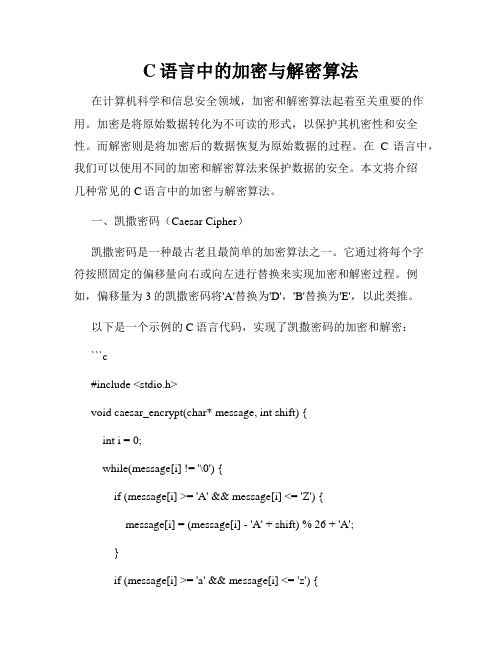
C语言中的加密与解密算法在计算机科学和信息安全领域,加密和解密算法起着至关重要的作用。
加密是将原始数据转化为不可读的形式,以保护其机密性和安全性。
而解密则是将加密后的数据恢复为原始数据的过程。
在C语言中,我们可以使用不同的加密和解密算法来保护数据的安全。
本文将介绍几种常见的C语言中的加密与解密算法。
一、凯撒密码(Caesar Cipher)凯撒密码是一种最古老且最简单的加密算法之一。
它通过将每个字符按照固定的偏移量向右或向左进行替换来实现加密和解密过程。
例如,偏移量为3的凯撒密码将'A'替换为'D','B'替换为'E',以此类推。
以下是一个示例的C语言代码,实现了凯撒密码的加密和解密:```c#include <stdio.h>void caesar_encrypt(char* message, int shift) {int i = 0;while(message[i] != '\0') {if (message[i] >= 'A' && message[i] <= 'Z') {message[i] = (message[i] - 'A' + shift) % 26 + 'A';}if (message[i] >= 'a' && message[i] <= 'z') {message[i] = (message[i] - 'a' + shift) % 26 + 'a';}i++;}}void caesar_decrypt(char* message, int shift) {int i = 0;while(message[i] != '\0') {if (message[i] >= 'A' && message[i] <= 'Z') {message[i] = (message[i] - 'A' - shift + 26) % 26 + 'A'; }if (message[i] >= 'a' && message[i] <= 'z') {message[i] = (message[i] - 'a' - shift + 26) % 26 + 'a'; }i++;}}int main() {char message[] = "Hello, World!";int shift = 3;caesar_encrypt(message, shift);printf("加密后的消息:%s\n", message);caesar_decrypt(message, shift);printf("解密后的消息:%s\n", message);return 0;}```该示例代码演示了如何使用凯撒密码对消息进行加密和解密。
欧姆龙C系列PLC加密解密方法
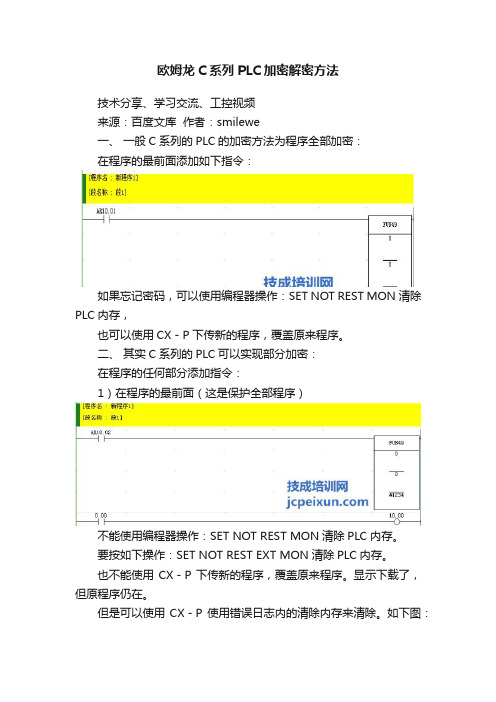
欧姆龙C系列PLC加密解密方法
技术分享、学习交流、工控视频
来源:百度文库作者:smilewe
一、一般C系列的PLC的加密方法为程序全部加密:
在程序的最前面添加如下指令:
如果忘记密码,可以使用编程器操作:SET NOT REST MON清除PLC内存,
也可以使用CX-P下传新的程序,覆盖原来程序。
二、其实C系列的PLC可以实现部分加密:
在程序的任何部分添加指令:
1)在程序的最前面(这是保护全部程序)
不能使用编程器操作:SET NOT REST MON清除PLC内存。
要按如下操作:SET NOT REST EXT MON清除PLC内存。
也不能使用CX-P下传新的程序,覆盖原来程序。
显示下载了,但原程序仍在。
但是可以使用CX-P使用错误日志内的清除内存来清除。
如下图:
2)加在程序的中间:
受保护的是在LD AR1002指令以后的程序,也就是只能读到部分程序。
如果使用编程器操作:SET NOT REST MON清除PLC内存,只能清除LD AR1002
以前的指令,不能清除LD AR1002以后程序。
要按如下操作:SET NOT REST EXT MON清除PLC内存。
也不能使用CX-P下传新的程序,覆盖原来程序。
显示下载了,但原程序仍在。
但是可以使用CX-P使用错误日志内的清除内存来清除。
赶快分享给小伙伴一起涨姿势吧!
将技成培训一键置顶,天天学技术!。
c语言课程设计-文件加密解密(含源代码)
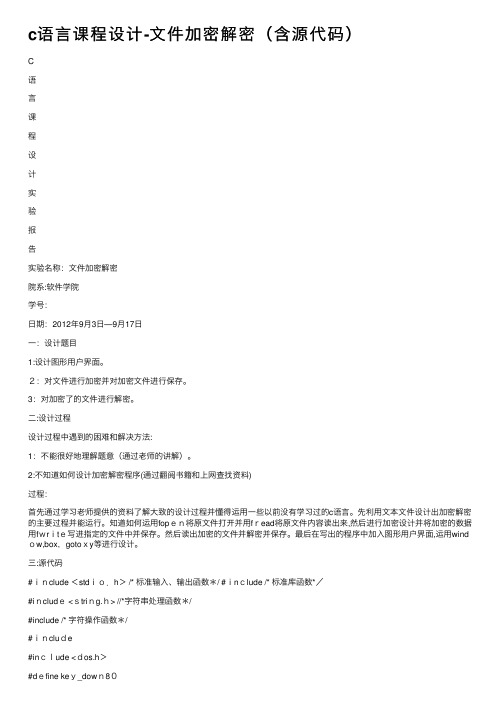
c语⾔课程设计-⽂件加密解密(含源代码)C语⾔课程设计实验报告实验名称:⽂件加密解密院系:软件学院学号:⽇期:2012年9⽉3⽇—9⽉17⽇⼀:设计题⽬1:设计图形⽤户界⾯。
2:对⽂件进⾏加密并对加密⽂件进⾏保存。
3:对加密了的⽂件进⾏解密。
⼆:设计过程设计过程中遇到的困难和解决⽅法:1:不能很好地理解题意(通过⽼师的讲解)。
2:不知道如何设计加密解密程序(通过翻阅书籍和上⽹查找资料)过程:⾸先通过学习⽼师提供的资料了解⼤致的设计过程并懂得运⽤⼀些以前没有学习过的c语⾔。
先利⽤⽂本⽂件设计出加密解密的主要过程并能运⾏。
知道如何运⽤fopen将原⽂件打开并⽤fread将原⽂件内容读出来,然后进⾏加密设计并将加密的数据⽤fwrite写进指定的⽂件中并保存。
然后读出加密的⽂件并解密并保存。
最后在写出的程序中加⼊图形⽤户界⾯,运⽤wind ow,box,gotoxy等进⾏设计。
三:源代码#include <stdio.h> /* 标准输⼊、输出函数*/ #include /* 标准库函数*/#include <string.h> //*字符串处理函数*/#include /* 字符操作函数*/#include#include <dos.h>#define key_down80#definekey_up 72#definekey_esc 1#define key_enter 28#defineSIZE 1void box(int startx,int starty,int high,intwidth);int get_key();char buf[20*20*4];/*////////////////////////////////////////////////////////////////////////////////////////////////////////////////////////////加密解密*/voidfun(char*list,char *sd)/*加密过程*/{FILE*fp1,*fp2;char buf[1000]; /*⽂件临时存放处*/register intch;fp1=fopen("e:\list.txt","r"); /*⽤可读⽅式打开⽂件*/fp2=fopen("e:\sd.txt","w"); /*⽤可写⽅式创建⼀个⽂件*/if(fp1==NULL){printf("cannot openfile\n");exit(1);}if(fp2==NULL){printf("cannot build file\n");exit(1);}ch=fgetc(fp1);/*读出打开⽂件的光标处的⼀个字符*/ while(!feof(fp1))/*读出的字符不是最后的字符*/ {ch=ch<<1; /*加密⽅法*/fputc(ch,fp2);/*加密的字符存放在指定的地⽅*/ch=fgetc(fp1);}rewind(fp2); /*将光标移动到第⼀个字符前⾯*/fread(buf,sizeof(buf),1,fp2); /*从⽂件的当前位置开始中读取buf中存放的数据*/printf("%s",buf);/*fclose(fp1);fclose(fp2);*/}void man(char *sd,char *ds)/*解密过程*/{/*int n=0;*/FILE *fp2,*fp3;register int fh;char buf1[1000];fp2=fopen("e:\sd.txt","rb"); /*⽤可读⽅式打开⽂件*/ fp3=fopen("e:\ds.txt","wb"); /*⽤可写⽅式创建⼀⽂件*/ if(fp2==NULL){printf("cannot open file\n");exit(1);}if(fp3==NULL){printf("cannot build file\n");exit(1);}fh=fgetc(fp2); /*从光标处读出⼀个字符*/while(!feof(fp2)) /*当读出的字符到达最后⼀个则停⽌*/{fh=fh>>1; /*解密⽅式*/fputc(fh,fp3);/*解密的字符存放在指定的地⽅*/fh=fgetc(fp2);}fread(buf1,sizeof(buf1),1,fp3); /*读出buf1中所存放的数据*/printf("%s",buf1);}void main(){int k;char*f[]={"jiami","jiemi"};/**界⾯的形式/ int key,y;int j,q;char list[300];char sd[300];char ds[300];char ch,fh;char buf[1000];char buf1[1000];FILE *fp1;FILE*fp2;intl1,l2;window(1,1,80,25); /*left,top,right,bottom,相对于屏幕的字符坐标,屏幕原点在左上⾓*/ gettext( 20,10,40,14,buf); /*保存矩形屏幕上的字符*/textbackground(7); /*背景颜⾊*/textcolor(0);/*字体颜⾊*/clrscr(); /*清除矩形屏幕上的所有字符*/gotoxy(24,10); /*将当前字符屏幕的光标位置移动到x,y的坐标位⼦*/printf("%s",f[0]);gotoxy(24,14);printf("%s",f[1]);gettext(10,8,60,16,buf);box(22,9,3,30);/*建⽴⼀个⼩窗⼝*/key=0;while(1){ while(bioskey(1)==0); /*读取键盘值查询键盘是否按下*/key=get_key(); /*按下了什么键盘*/if(key==key_up||key==key_down){y=wherey(); /*得到字符模式下窗⼝光标的x坐标数值*/if(key==key_up)y=y==10? y+4:10;/*当y=10光标向下移动四个位置否则将光标移动到y=10处*/if(key==key_down)y=y==14? y-4:14; /*当y=14光标向下移动四个位置否则将光标移动到y=14处*/puttext(10,8,60,16,buf); /*将gettext函数保存的字符恢复到屏幕上*/gotoxy(24,y);if(y==10){ textbackground(7);textcolor(0);box(22,9,3,30);textbackground(3);textcolor(15);gotoxy(24,y);cprintf("%s",f[0]);}else{ textbackground(7);textcolor(0);box(22,13,3,30);textbackground(3);textcolor(15);gotoxy(24,y);cprintf("%s",f[1]);}}if(key==key_enter&&y==10)且光标在y=10处 /*当按下enter键且光标在y=10处进⾏下步*/{clrscr();textbackground(3);textcolor(15);/*clrscr(); */gotoxy(24,5);printf("input the file name for jiami\n");/*⽤户给需要加密的⽂件加密*/l1=strlen("input the file name for jiami:"); /*待求长度的字符串指针*/gotoxy(24+l1,5);scanf("%s",list);gotoxy(24,10);printf("input file name forsave\n");/*给加密后的⽂件命名,并保存*/l2=strlen("input file name forsave:");gotoxy(24+l2,10);scanf("%s",sd);fun(list,sd);fp1=fopen("e:\sd.txt","rb");fread(buf1,sizeof(buf1),1,fp1);gotoxy(10,15);printf("%s\n",buf1);getch();printf("file haven jiami ,save now");getche(); break;}if(key==key_enter&&y==14){clrscr();textbackground(3);textcolor(15);gotoxy(24,5);printf("input the file namefor jiemi \n");/*⽤户给需要解密的⽂件解密 */l1=strlen("input the file namefor jiemi: ");gotoxy(24+l1,5);scanf("%s",sd);gotoxy(24,10);printf("input file name for save:\n");/*对解密的⽂件系统⼜可以提供保存路径 */l2=strlen("input file name for s ave: ");gotoxy(24+l2,10);scanf("%s",ds);man(sd,ds);fp2=fopen("e:\ds.txt","rb");fread(buf1,sizeof(buf1),1,fp2);gotoxy(10,15);printf("%s\n",buf1);getch();printf("file haven jiemi,save now");getche();break;}}window(1,1,80,25);gettext( 20,10,40,14,buf);textcolor(0);clrscr();gotoxy(24,10);printf("%s",f[0]);gotoxy(24,14);printf("%s",f[1]);gettext(10,8,60,16,buf);box(22,9,3,30);key=0;while(1){ while(bioskey(1)==0);key=get_key();if(key==key_up||key==key_down){y=wherey();if(key==key_up)y=y==10? y+4:10;if(key==key_down)y=y==14?y-4:14;puttext(10,8,60,16,buf);gotoxy(24,y);if(y==10) /*光标在10处的窗⼝*/{ textbackground(7);textcolor(0);box(22,9,3,30);textbackground(3);textcolor(15);gotoxy(24,y);cprintf("%s",f[0]);}else{ textbackground(7);textcolor(0);box(22,13,3,30);textcolor(15);gotoxy(24,y);cprintf("%s",f[1]);}}if(key==key_enter&&y==10){clrscr();textbackground(3);textcolor(15);/*clrscr(); */gotoxy(24,5);printf("input thefile name for jiami\n");/*⽤户给需要加密的⽂件加密 */ l1=strlen("input the file name for jiami:");gotoxy(24+l1,5);scanf("%s",list);gotoxy(24,10);printf("input file name for save\n");/*给加密后的⽂件命名,并保存*/l2=strlen("input file name for save:");gotoxy(24+l2,10);scanf("%s",sd);fun(list,sd);fp1=fopen("e:\sd.txt","rb");fread(buf1,sizeof(buf1),1,fp1);gotoxy(10,15);printf("%s\n",buf1);getch();printf("file haven jiami ,save now");getche();}if(key==key_enter&&y==14){clrscr();textbackground(3);textcolor(15);gotoxy(24,5);printf("input the file name for jiemi \n");/*⽤户给需要解密的⽂件解密*/l1=strlen("input the file name forjiemi:");gotoxy(24+l1,5);scanf("%s",sd);gotoxy(24,10);printf("input filenamefor save:\n");/*对解密的⽂件系统⼜可以提供保存路径*/l2=strlen("input file name for save: ");gotoxy(24+l2,10);scanf("%s",ds);man(sd,ds);fp2=fopen("e:\ds.txt","rb");fread(buf1,sizeof(buf1),1,fp2);gotoxy(10,15);printf("%s\n",buf1);getch();printf("file haven jiemi,save now");getche();break;}}}int get_key(){union REGS rg;rg.h.ah=0;int86(0x16,&rg,&rg);return rg.h.ah;getchar();}void box(intstartx,int starty,int high,intwidth) /*屏幕的建⽴*/{int i;gotoxy(startx,starty);putch(0xda);for (i=startx+1;iputch(0xc4);putch(0xbf);for(i=starty+1;i <high+starty;i++){gotoxy(startx,i);putch(0xb3);gotoxy(width,i);putch(0xb3);}gotoxy(startx,starty+high-1);putch(0xc0);gotoxy(startx+1,starty+high-1);for(i=startx+1;iputch(0xc4);putch(0xd9);return;}四:⼼得体会通过这次的作业我觉得最⼤的收获是不仅把平时学习到的知识理解的更加透彻,⽽且使知识更加系统化,同时还把有些平时不太注意的⼩问题发现了出来,这不但有利于我学习C语⾔,⽽且对于我学习任何⼀门课程都是很有益处的。
c语言程序设计文件加密解密
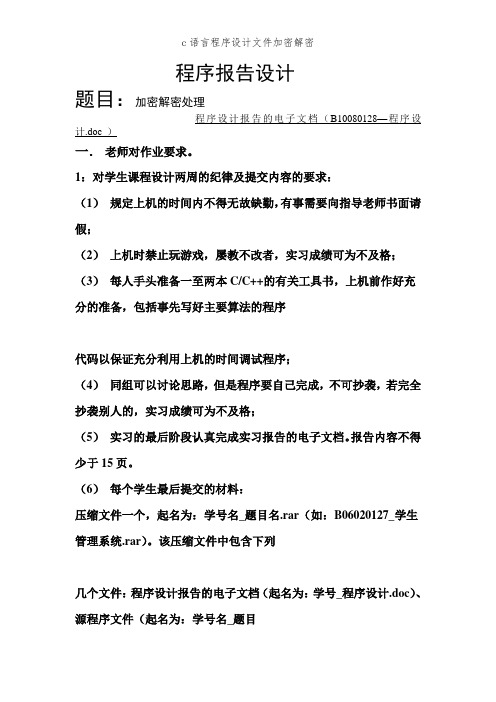
程序报告设计题目:加密解密处理程序设计报告的电子文档(B10080128—程序设计.doc )一.老师对作业要求。
1:对学生课程设计两周的纪律及提交内容的要求:(1)规定上机的时间内不得无故缺勤,有事需要向指导老师书面请假;(2)上机时禁止玩游戏,屡教不改者,实习成绩可为不及格;(3)每人手头准备一至两本C/C++的有关工具书,上机前作好充分的准备,包括事先写好主要算法的程序代码以保证充分利用上机的时间调试程序;(4)同组可以讨论思路,但是程序要自己完成,不可抄袭,若完全抄袭别人的,实习成绩可为不及格;(5)实习的最后阶段认真完成实习报告的电子文档。
报告内容不得少于15页。
(6)每个学生最后提交的材料:压缩文件一个,起名为:学号名_题目名.rar(如:B06020127_学生管理系统.rar)。
该压缩文件中包含下列几个文件:程序设计报告的电子文档(起名为:学号_程序设计.doc)、源程序文件(起名为:学号名_题目名.cpp,如:B06020127_学生管理系统.cpp)、原始数据文件(如:stud.dat)、编译链接后得到的可执行文件(起名为:学号名_题目名.exe)(7)请同学独立完成报告,若发现两份报告一模一样,则两人都按不及格论处,请各位同学珍惜自己的版权,也请指导老师严格把关。
附2:上机时间:每天上午8:00——11:20附3:成绩的评定根据学生平时的上机出勤情况、为上机所作的准备情况、上机时的表现、程序的完成情况、报告的完成情况、验收答辩时的表现等综合打分。
等级为:优秀、良好、中等、及格、不及格。
附4:课程设计报告具体内容要求学生管理系统(题目格式:宋体,3号,加粗,居中对齐)一、课题内容和要求(格式:宋体,4号,加粗,两端对齐)该部分可参考前面给出的问题描述再加以细化一些(正文格式:宋体,小4号,不加粗,两端对齐,1.5倍行距)二、需求分析(格式:宋体,4号,加粗,两端对齐)在该部分中叙述每个模块的功能要求(正文格式:宋体,小4号,不加粗,两端对齐,1.5倍行距)概要设计(格式:宋体,4号,加粗,两端对齐)在此说明每个部分的算法设计说明(可以是描述算法的流程图),每个程序中使用的存储结构设计说明(如果指定存储结构请写出该存储结构的定义,如果用面向对象的方法,应该给出类中成员变量和成员函数原型声明)。
C语言加密与解密算法的实现与应用
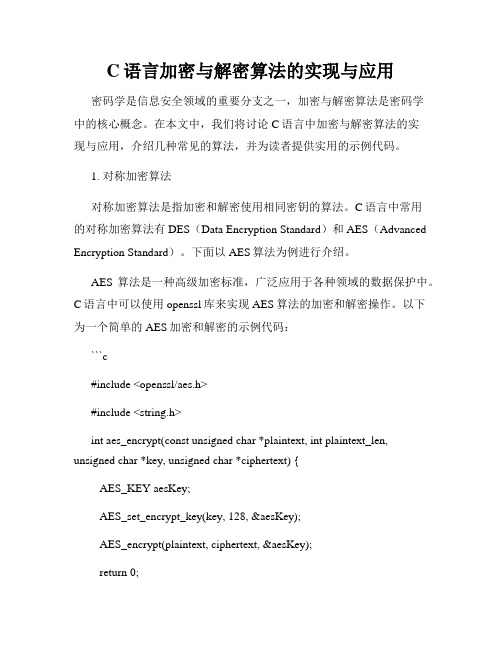
C语言加密与解密算法的实现与应用密码学是信息安全领域的重要分支之一,加密与解密算法是密码学中的核心概念。
在本文中,我们将讨论C语言中加密与解密算法的实现与应用,介绍几种常见的算法,并为读者提供实用的示例代码。
1. 对称加密算法对称加密算法是指加密和解密使用相同密钥的算法。
C语言中常用的对称加密算法有DES(Data Encryption Standard)和AES(Advanced Encryption Standard)。
下面以AES算法为例进行介绍。
AES算法是一种高级加密标准,广泛应用于各种领域的数据保护中。
C语言中可以使用openssl库来实现AES算法的加密和解密操作。
以下为一个简单的AES加密和解密的示例代码:```c#include <openssl/aes.h>#include <string.h>int aes_encrypt(const unsigned char *plaintext, int plaintext_len, unsigned char *key, unsigned char *ciphertext) {AES_KEY aesKey;AES_set_encrypt_key(key, 128, &aesKey);AES_encrypt(plaintext, ciphertext, &aesKey);return 0;int aes_decrypt(const unsigned char *ciphertext, int ciphertext_len, unsigned char *key, unsigned char *plaintext) {AES_KEY aesKey;AES_set_decrypt_key(key, 128, &aesKey);AES_decrypt(ciphertext, plaintext, &aesKey);return 0;}int main() {unsigned char key[] = "0123456789012345";unsigned char plaintext[] = "Hello, World!";unsigned char ciphertext[128];unsigned char decryptedtext[128];aes_encrypt(plaintext, strlen((char *)plaintext), key, ciphertext);aes_decrypt(ciphertext, strlen((char *)ciphertext), key, decryptedtext);printf("Plaintext: %s\n", plaintext);printf("Ciphertext: %s\n", ciphertext);printf("Decrypted text: %s\n", decryptedtext);return 0;```2. 非对称加密算法非对称加密算法使用一对密钥,分别为公钥和私钥。
C语言网络通信加密与解密技术

C语言网络通信加密与解密技术随着互联网的快速发展,网络通信已经成为了人们日常生活中必不可少的一部分。
然而,随之而来的网络安全问题也变得越来越严峻。
为了保护数据的安全性,许多通信协议和加密算法被广泛应用。
本文将探讨C语言中网络通信加密与解密技术的实现方法。
一、概述网络通信加密技术是指通过对数据进行加密,使得数据在传输过程中不易被非法获取和篡改。
而解密技术则是恢复被加密的数据,确保数据的完整性和可读性。
在C语言中,可以利用各种加密算法对数据进行加密和解密操作。
二、对称加密算法对称加密算法是指加密和解密使用相同的密钥的算法。
其中,常用的对称加密算法包括DES、3DES、AES等。
在C语言中,可以通过调用相应的库函数来实现对称加密算法。
1. DES算法DES(Data Encryption Standard)是一种使用对称密钥加密方式的块加密算法。
它将明文按照64比特(位)长度进行分组,并经过一系列复杂的操作,输出加密后的密文。
在C语言中,可以使用OpenSSL等库函数实现DES算法的加密和解密操作。
2. 3DES算法3DES(Triple Data Encryption Standard)是对DES算法的改进和扩展。
它使用三个不同的密钥对数据进行加密,增加了加密的强度和安全性。
在C语言中,可以使用OpenSSL等库函数来实现3DES算法的加密和解密操作。
3. AES算法AES(Advanced Encryption Standard)是一种用于保护敏感数据的高级加密标准。
它的密钥长度可以是128比特、192比特或256比特,提供了更高的安全性和效率。
在C语言中,可以使用OpenSSL等库函数来实现AES算法的加密和解密操作。
三、非对称加密算法非对称加密算法是指加密和解密使用不同的密钥的算法。
其中,常用的非对称加密算法包括RSA、DSA、ECC等。
在C语言中,可以通过调用相应的库函数来实现非对称加密算法。
C#加密解密

C#加密解密C#加密解密⼤全1、⽅法⼀ (不可逆加密)复制代码复制代码public string EncryptPassword(string PasswordString,string PasswordFormat ){string encryptPassword = null;if (PasswordFormat="SHA1"){encryptPassword=FormsAuthortication.HashPasswordForStoringInConfigFile(PasswordString ,"SHA1"); }elseif (PasswordFormat="MD5"){encryptPassword=FormsAuthortication.HashPasswordForStoringInConfigFile(PasswordString ,"MD5"); }return encryptPassword ;}复制代码复制代码2、⽅法⼆ (可逆加密)复制代码复制代码public interface IBindesh{string encode(string str);string decode(string str);}public class EncryptionDecryption : IBindesh{public string encode(string str){string htext = "";for ( int i = 0; i < str.Length; i++){htext = htext + (char) (str[i] + 10 - 1 * 2);}return htext;}public string decode(string str){string dtext = "";for ( int i=0; i < str.Length; i++){dtext = dtext + (char) (str[i] - 10 + 1*2);}return dtext;}复制代码复制代码3、⽅法三 (可逆加密)复制代码复制代码const string KEY_64 = “VavicApp”;//注意了,是8个字符,64位const string IV_64 = "VavicApp";public string Encode(string data){byte[] byKey = System.Text.ASCIIEncoding.ASCII.GetBytes(KEY_64);byte[] byIV = System.Text.ASCIIEncoding.ASCII.GetBytes(IV_64);DESCryptoServiceProvider cryptoProvider = new DESCryptoServiceProvider();int i = cryptoProvider.KeySize;MemoryStream ms = new MemoryStream();CryptoStream cst = new CryptoStream(ms, cryptoProvider.CreateEncryptor(byKey, byIV), CryptoStreamMode.Write);StreamWriter sw = new StreamWriter(cst);sw.Write(data);sw.Flush();cst.FlushFinalBlock();sw.Flush();return Convert.ToBase64String(ms.GetBuffer(), 0, (int)ms.Length);}public string Decode(string data){byte[] byKey = System.Text.ASCIIEncoding.ASCII.GetBytes(KEY_64);byte[] byIV = System.Text.ASCIIEncoding.ASCII.GetBytes(IV_64);byte[] byEnc;try{byEnc = Convert.FromBase64String(data);}catch{return null;}DESCryptoServiceProvider cryptoProvider = new DESCryptoServiceProvider();MemoryStream ms = new MemoryStream(byEnc);CryptoStream cst = new CryptoStream(ms, cryptoProvider.CreateDecryptor(byKey, byIV), CryptoStreamMode.Read); StreamReader sr = new StreamReader(cst);return sr.ReadToEnd();}复制代码复制代码4、MD5不可逆加密 (32位加密)复制代码复制代码public string GetMD5(string s, string _input_charset){/** <summary>/// 与ASP兼容的MD5加密算法/// </summary>MD5 md5 = new MD5CryptoServiceProvider();byte[] t = puteHash(Encoding.GetEncoding(_input_charset).GetBytes(s));StringBuilder sb = new StringBuilder(32);for (int i = 0; i < t.Length; i++){sb.Append(t[i].ToString("x").PadLeft(2, '0'));}return sb.ToString();}复制代码复制代码(16位加密)复制代码复制代码public static string GetMd5Str(string ConvertString){MD5CryptoServiceProvider md5 = new MD5CryptoServiceProvider();string t2 = BitConverter.ToString(puteHash(UTF8Encoding.Default.GetBytes(ConvertString)), 4, 8); t2 = t2.Replace("-", "");return t2;}复制代码复制代码5、加解⽂本⽂件复制代码复制代码private static void EncryptData(String inName, String outName, byte[] desKey, byte[] desIV){//Create the file streams to handle the input and output files.FileStream fin = new FileStream(inName, FileMode.Open, FileAccess.Read);FileStream fout = new FileStream(outName, FileMode.OpenOrCreate, FileAccess.Write);fout.SetLength(0);//Create variables to help with read and write.byte[] bin = new byte[100]; //This is intermediate storage for the encryption.long rdlen = 0; //This is the total number of bytes written.long totlen = fin.Length; //This is the total length of the input file.int len; //This is the number of bytes to be written at a time.DES des = new DESCryptoServiceProvider();CryptoStream encStream = new CryptoStream(fout, des.CreateEncryptor(desKey, desIV), CryptoStreamMode.Write);//Read from the input file, then encrypt and write to the output file.while (rdlen < totlen){len = fin.Read(bin, 0, 100);encStream.Write(bin, 0, len);rdlen = rdlen + len;}encStream.Close();fout.Close();fin.Close();}//解密⽂件private static void DecryptData(String inName, String outName, byte[] desKey, byte[] desIV){//Create the file streams to handle the input and output files.FileStream fin = new FileStream(inName, FileMode.Open, FileAccess.Read);FileStream fout = new FileStream(outName, FileMode.OpenOrCreate, FileAccess.Write);fout.SetLength(0);//Create variables to help with read and write.byte[] bin = new byte[100]; //This is intermediate storage for the encryption.long rdlen = 0; //This is the total number of bytes written.long totlen = fin.Length; //This is the total length of the input file.int len; //This is the number of bytes to be written at a time.DES des = new DESCryptoServiceProvider();CryptoStream encStream = new CryptoStream(fout, des.CreateDecryptor(desKey, desIV), CryptoStreamMode.Write);//Read from the input file, then encrypt and write to the output file.while (rdlen < totlen){len = fin.Read(bin, 0, 100);encStream.Write(bin, 0, len);rdlen = rdlen + len;}encStream.Close();fout.Close();fin.Close();}复制代码复制代码6.复制代码using System;using System.Collections.Generic; using System.Text;using System.Security.Cryptography; using System.IO;namespace Component{public class Security{public Security(){}//默认密钥向量private static byte[] Keys = { 0x12, 0x34, 0x56, 0x78, 0x90, 0xAB, 0xCD, 0xEF };/**//**//** <summary>/// DES加密字符串/// </summary>/// <param name="encryptString">待加密的字符串</param>/// <param name="encryptKey">加密密钥,要求为8位</param>/// <returns>加密成功返回加密后的字符串,失败返回源串</returns>public static string EncryptDES(string encryptString, string encryptKey){try{byte[] rgbKey = Encoding.UTF8.GetBytes(encryptKey.Substring(0, 8));byte[] rgbIV = Keys;byte[] inputByteArray = Encoding.UTF8.GetBytes(encryptString);DESCryptoServiceProvider dCSP = new DESCryptoServiceProvider();MemoryStream mStream = new MemoryStream();CryptoStream cStream = new CryptoStream(mStream, dCSP.CreateEncryptor(rgbKey, rgbIV), CryptoStreamMode.Write); cStream.Write(inputByteArray, 0, inputByteArray.Length);cStream.FlushFinalBlock();return Convert.ToBase64String(mStream.ToArray());}catch{return encryptString;}}/**//**//** <summary>/// DES解密字符串/// </summary>/// <param name="decryptString">待解密的字符串</param>/// <param name="decryptKey">解密密钥,要求为8位,和加密密钥相同</param>/// <returns>解密成功返回解密后的字符串,失败返源串</returns>public static string DecryptDES(string decryptString, string decryptKey){try{byte[] rgbKey = Encoding.UTF8.GetBytes(decryptKey);byte[] rgbIV = Keys;byte[] inputByteArray = Convert.FromBase64String(decryptString);DESCryptoServiceProvider DCSP = new DESCryptoServiceProvider();MemoryStream mStream = new MemoryStream();CryptoStream cStream = new CryptoStream(mStream, DCSP.CreateDecryptor(rgbKey, rgbIV), CryptoStreamMode.Write); cStream.Write(inputByteArray, 0, inputByteArray.Length);cStream.FlushFinalBlock();return Encoding.UTF8.GetString(mStream.ToArray());}catch{return decryptString;}}}}。
C加密解密算法
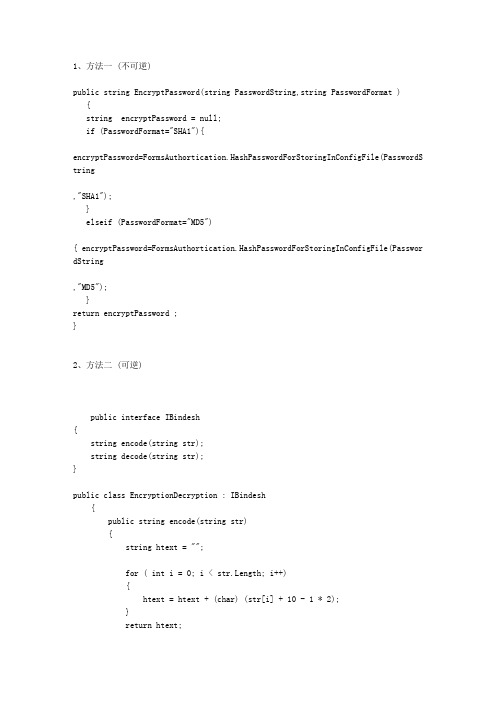
1、方法一 (不可逆)public string EncryptPassword(string PasswordString,string PasswordFormat ){string encryptPassword = null;if (PasswordFormat="SHA1"){encryptPassword=FormsAuthortication.HashPasswordForStoringInConfigFile(PasswordS tring,"SHA1");}elseif (PasswordFormat="MD5"){ encryptPassword=FormsAuthortication.HashPasswordForStoringInConfigFile(Passwor dString,"MD5");}return encryptPassword ;}2、方法二 (可逆)public interface IBindesh{string encode(string str);string decode(string str);}public class EncryptionDecryption : IBindesh{public string encode(string str){string htext = "";for ( int i = 0; i < str.Length; i++){htext = htext + (char) (str[i] + 10 - 1 * 2);}return htext;public string decode(string str){string dtext = "";for ( int i=0; i < str.Length; i++){dtext = dtext + (char) (str[i] - 10 + 1*2);}return dtext;}3、方法三 (可逆)const string KEY_64 = "VavicApp";//注意了,是8个字符,64位const string IV_64 = "VavicApp";public string Encode(string data){byte[] byKey = System.Text.ASCIIEncoding.ASCII.GetBytes(KEY_64);byte[] byIV = System.Text.ASCIIEncoding.ASCII.GetBytes(IV_64);DESCryptoServiceProvider cryptoProvider = new DESCryptoServiceProvider();int i = cryptoProvider.KeySize;MemoryStream ms = new MemoryStream();CryptoStream cst = new CryptoStream(ms, cryptoProvider.CreateEncryptor(byKey,byIV), CryptoStreamMode.Write);StreamWriter sw = new StreamWriter(cst);sw.Write(data);sw.Flush();cst.FlushFinalBlock();sw.Flush();return Convert.ToBase64String(ms.GetBuffer(), 0, (int)ms.Length);public string Decode(string data){byte[] byKey = System.Text.ASCIIEncoding.ASCII.GetBytes(KEY_64);byte[] byIV = System.Text.ASCIIEncoding.ASCII.GetBytes(IV_64);byte[] byEnc;try{byEnc = Convert.FromBase64String(data);}catch{return null;}DESCryptoServiceProvider cryptoProvider = new DESCryptoServiceProvider();MemoryStream ms = new MemoryStream(byEnc);CryptoStream cst = new CryptoStream(ms, cryptoProvider.CreateDecryptor(byKey,byIV), CryptoStreamMode.Read);StreamReader sr = new StreamReader(cst);return sr.ReadToEnd();}4、MD5不可逆加密(32位加密)public string GetMD5(string s, string _input_charset){/**//**//**//// <summary>/// 与ASP兼容的MD5加密算法/// </summary>MD5 md5 = new MD5CryptoServiceProvider();byte[] t = puteHash(Encoding.GetEncoding(_input_charset).GetBytes(s));StringBuilder sb = new StringBuilder(32);for (int i = 0; i < t.Length; i++){sb.Append(t[i].ToString("x").PadLeft(2, '0'));}return sb.ToString();}(16位加密)public static string GetMd5Str(string ConvertString){MD5CryptoServiceProvider md5 = new MD5CryptoServiceProvider();string t2 =BitConverter.ToString(puteHash(UTF8Encoding.Default.GetBytes(ConvertStrin g)), 4, 8);t2 = t2.Replace("-", "");return t2;}5、加解文本文件//加密文件private static void EncryptData(String inName, String outName, byte[] desKey, byte[]desIV){//Create the file streams to handle the input and output files.FileStream fin = new FileStream(inName, FileMode.Open, FileAccess.Read); FileStream fout = new FileStream(outName, FileMode.OpenOrCreate, FileAccess.Write);fout.SetLength(0);//Create variables to help with read and write.byte[] bin = new byte[100]; //This is intermediate storage for the encryption.long rdlen = 0; //This is the total number of bytes written. long totlen = fin.Length; //This is the total length of the input file. int len; //This is the number of bytes to be written ata time.DES des = new DESCryptoServiceProvider();CryptoStream encStream = new CryptoStream(fout, des.CreateEncryptor(desKey, desIV),CryptoStreamMode.Write);//Read from the input file, then encrypt and write to the output file.while (rdlen < totlen){len = fin.Read(bin, 0, 100);encStream.Write(bin, 0, len);rdlen = rdlen + len;}encStream.Close();fout.Close();fin.Close();}//解密文件private static void DecryptData(String inName, String outName, byte[] desKey, byte[]desIV){//Create the file streams to handle the input and output files.FileStream fin = new FileStream(inName, FileMode.Open, FileAccess.Read); FileStream fout = new FileStream(outName, FileMode.OpenOrCreate, FileAccess.Write);fout.SetLength(0);//Create variables to help with read and write.byte[] bin = new byte[100]; //This is intermediate storage for the encryption.long rdlen = 0; //This is the total number of bytes written. long totlen = fin.Length; //This is the total length of the input file. int len; //This is the number of bytes to be written at a time.DES des = new DESCryptoServiceProvider();CryptoStream encStream = new CryptoStream(fout, des.CreateDecryptor(desKey, desIV),CryptoStreamMode.Write);//Read from the input file, then encrypt and write to the output file. while (rdlen < totlen){len = fin.Read(bin, 0, 100);encStream.Write(bin, 0, len);rdlen = rdlen + len;}encStream.Close();fout.Close();fin.Close();}6、using System;using System.Collections.Generic;using System.Text;using System.Security.Cryptography;using System.IO;namespace Component{public class Security{public Security(){}//默认密钥向量private static byte[] Keys = { 0x12, 0x34, 0x56, 0x78, 0x90, 0xAB, 0xCD, 0xEF };/**//**//**//**//**//**//**//// <summary>/// DES加密字符串/// </summary>/// <param name="encryptString">待加密的字符串</param>/// <param name="encryptKey">加密密钥,要求为8位</param>/// <returns>加密成功返回加密后的字符串,失败返回源串</returns>public static string EncryptDES(string encryptString, string encryptKey){try{byte[] rgbKey = Encoding.UTF8.GetBytes(encryptKey.Substring(0, 8));byte[] rgbIV = Keys;byte[] inputByteArray = Encoding.UTF8.GetBytes(encryptString); DESCryptoServiceProvider dCSP = new DESCryptoServiceProvider(); MemoryStream mStream = new MemoryStream();CryptoStream cStream = new CryptoStream(mStream, dCSP.CreateEncryptor(rgbKey,rgbIV), CryptoStreamMode.Write);cStream.Write(inputByteArray, 0, inputByteArray.Length);cStream.FlushFinalBlock();return Convert.ToBase64String(mStream.ToArray());}catch{return encryptString;}}/**//**//**//**//**//**//**//// <summary>/// DES解密字符串/// </summary>/// <param name="decryptString">待解密的字符串</param>/// <param name="decryptKey">解密密钥,要求为8位,和加密密钥相同</param> /// <returns>解密成功返回解密后的字符串,失败返源串</returns>public static string DecryptDES(string decryptString, string decryptKey) {try{byte[] rgbKey = Encoding.UTF8.GetBytes(decryptKey);byte[] rgbIV = Keys;byte[] inputByteArray = Convert.FromBase64String(decryptString); DESCryptoServiceProvider DCSP = new DESCryptoServiceProvider(); MemoryStream mStream = new MemoryStream();CryptoStream cStream = new CryptoStream(mStream, DCSP.CreateDecryptor(rgbKey,rgbIV), CryptoStreamMode.Write);cStream.Write(inputByteArray, 0, inputByteArray.Length);cStream.FlushFinalBlock();return Encoding.UTF8.GetString(mStream.ToArray()); }catch{return decryptString;}}}}。
C语言实现加密解密功能
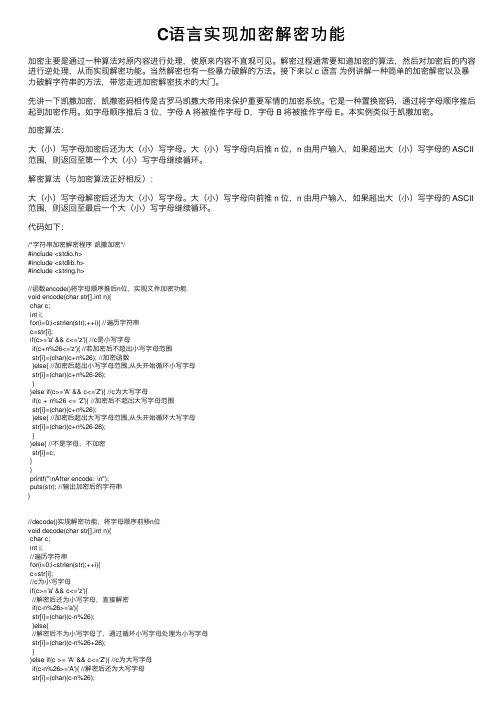
C语⾔实现加密解密功能加密主要是通过⼀种算法对原内容进⾏处理,使原来内容不直观可见。
解密过程通常要知道加密的算法,然后对加密后的内容进⾏逆处理,从⽽实现解密功能。
当然解密也有⼀些暴⼒破解的⽅法。
接下来以 c 语⾔为例讲解⼀种简单的加密解密以及暴⼒破解字符串的⽅法,带您⾛进加密解密技术的⼤门。
先讲⼀下凯撒加密,凯撒密码相传是古罗马凯撒⼤帝⽤来保护重要军情的加密系统。
它是⼀种置换密码,通过将字母顺序推后起到加密作⽤。
如字母顺序推后 3 位,字母 A 将被推作字母 D,字母 B 将被推作字母 E。
本实例类似于凯撒加密。
加密算法:⼤(⼩)写字母加密后还为⼤(⼩)写字母。
⼤(⼩)写字母向后推 n 位,n 由⽤户输⼊,如果超出⼤(⼩)写字母的 ASCII 范围,则返回⾄第⼀个⼤(⼩)写字母继续循环。
解密算法(与加密算法正好相反):⼤(⼩)写字母解密后还为⼤(⼩)写字母。
⼤(⼩)写字母向前推 n 位,n 由⽤户输⼊,如果超出⼤(⼩)写字母的 ASCII 范围,则返回⾄最后⼀个⼤(⼩)写字母继续循环。
代码如下:/*字符串加密解密程序凯撒加密*/#include <stdio.h>#include <stdlib.h>#include <string.h>//函数encode()将字母顺序推后n位,实现⽂件加密功能void encode(char str[],int n){char c;int i;for(i=0;i<strlen(str);++i){ //遍历字符串c=str[i];if(c>='a' && c<='z'){ //c是⼩写字母if(c+n%26<='z'){ //若加密后不超出⼩写字母范围str[i]=(char)(c+n%26); //加密函数}else{ //加密后超出⼩写字母范围,从头开始循环⼩写字母str[i]=(char)(c+n%26-26);}}else if(c>='A' && c<='Z'){ //c为⼤写字母if(c + n%26 <= 'Z'){ //加密后不超出⼤写字母范围str[i]=(char)(c+n%26);}else{ //加密后超出⼤写字母范围,从头开始循环⼤写字母str[i]=(char)(c+n%26-26);}}else{ //不是字母,不加密str[i]=c;}}printf("\nAfter encode: \n");puts(str); //输出加密后的字符串}//decode()实现解密功能,将字母顺序前移n位void decode(char str[],int n){char c;int i;//遍历字符串for(i=0;i<strlen(str);++i){c=str[i];//c为⼩写字母if(c>='a' && c<='z'){//解密后还为⼩写字母,直接解密if(c-n%26>='a'){str[i]=(char)(c-n%26);}else{//解密后不为⼩写字母了,通过循环⼩写字母处理为⼩写字母str[i]=(char)(c-n%26+26);}}else if(c >= 'A' && c<='Z'){ //c为⼤写字母if(c-n%26>='A'){ //解密后还为⼤写字母str[i]=(char)(c-n%26);}else{ //解密后不为⼤写字母了,循环⼤写字母,处理为⼤写字母str[i]=(char)(c-n%26+26);}}else{ //⾮字母不处理str[i]=c;}}printf("\nAfter decode: \n");puts(str); //输出解密后的字符串}//该函数代码有冗余,读者可改进int main(){char str[50];int k=0,n=0,i=1;printf("\nPlease input strings: ");scanf("%s",str); //输⼊加密解密字符串//打印菜单printf("-----------------\n");printf("1: Encryption\n");printf("2: Decryption\n");printf("3: Violent Crack\n"); //暴⼒破解printf("-----------------\n");printf("\nPlease choose: ");scanf("%d",&k);if(k==1){ //加密printf("\nPlease input number: ");scanf("%d",&n);encode(str,n);}else if(k==2){ //解密printf("\nPlease input number: ");scanf("%d",&n);decode(str,n);}else{for(i=1;i<=25;++i){ //尝试所有可能的n值进⾏暴⼒破解printf("%d ",i);decode(str,i);}}return 0;}测试运⾏如下:成功实现加密解密功能,读者可以稍加改造完成对⽂件的加密解密以上就是本⽂的全部内容,希望对⼤家的学习有所帮助,也希望⼤家多多⽀持。
C语言课程设计数据的加密与解密

《C语言课程设计》课程设计报告题目数据的加密与解密学号XXXXXXXX姓名XXX年级专业2011级通信工程指导教师蔡继盛完成日期2012 年 6 月 4 日安徽师范大学物理与电子信息学院College of Physics and Electronic Information, Anhui Normal University目录课程设计任务书 (3)摘要 (4)关键词 (4)原理 (4)一.系统功能分析 (5)1.1设计目的 (5)1.2功能描述 (5)二.C 语言程序编写 (6)2.1程序结构图 (6)2.2程序流程图 (6)2.3程序源代码 (8)三.程序功能示例 (13)3.1示例截图 (13)3.2测试过程 (16)四.设计体会与收获 (16)五.参考文献 (16)《C 语言程序》课程设计任务书摘要:作为保障数据数据安全的一种方式,对于信息的加密技巧起源于欧洲,最广为人知的编码机器是德国的German Enigma,在第二次世界大战中德国人利用它创建了加密信息系统,从而解决军事信息的保密通讯问题。
尽管加密技术被首先使用在军事通信领域,但是人们或许出于安全的考虑,开始逐渐对于商业机密、政府文件等重要信息实施加密手段。
数据加密应运而生。
其基本原理是:对明文(可读懂的信息)进行翻译,使用不同的算法对明文以代码形式(密码)实施加密。
该过程的逆过程称为解密,即将该编码信息转化为明文的过程。
从事数据加密研究的人称为密码编码者(Cryptographer),而从事对数据解密的专业人士称为密码分析者(Cryptanalyst)。
如今数据加密技术被广泛地应用与国民经济各个领域,特别是政府机关和国防情报部门,此外才是科学研究机关、商业部门、新闻出版、金融证券、交通管制与电力输送等部门。
而C语言程序设计教学不仅仅局限于使学生单纯地了解和掌握C语言的基本语法规范,而是要致力于培养学生运用C语言解决实际问题的编程能力。
2019-2-20C#开发中常用加密解密方法解析

2019-2-20C#开发中常⽤加密解密⽅法解析C#开发中常⽤加密解密⽅法解析⼀、MD5加密算法我想这是⼤家都常听过的算法,可能也⽤的⽐较多。
那么什么是MD5算法呢?MD5全称是message-digest algorithm 5【|ˈmesidʒ|-|daiˈdʒest|-|ˈælɡəriðəm|】,简单的说就是单向的加密,即是说⽆法根据密⽂推导出明⽂。
MD5主要⽤途:1、对⼀段信息⽣成信息摘要,该摘要对该信息具有唯⼀性,可以作为数字签名。
2、⽤于验证⽂件的有效性(是否有丢失或损坏的数据),3、对⽤户密码的加密,4、在哈希函数中计算散列值从上边的主要⽤途中我们看到,由于算法的某些不可逆特征,在加密应⽤上有较好的安全性。
通过使⽤MD5加密算法,我们输⼊⼀个任意长度的字节串,都会⽣成⼀个128位的整数。
所以根据这⼀点MD5被⼴泛的⽤作密码加密。
下⾯我就像⼤家演⽰⼀下怎样进⾏密码加密。
先看下演⽰效果:具体代码如下:⾸先需要引⼊命名空间:using System.Security;using System.Security.Cryptography;private void btnmd5_Click(object sender, EventArgs e){MD5 md5 = new MD5CryptoServiceProvider();byte[] palindata = Encoding.Default.GetBytes(txtyuan.Text);//将要加密的字符串转换为字节数组byte[] encryptdata=puteHash(palindata);//将字符串加密后也转换为字符数组txtjiami.Text = Convert.ToBase64String(encryptdata);//将加密后的字节数组转换为加密字符串}这⾥我们需要注意的是,不论是在加密的过程中,加密前要将加密字符串转为字节数组,加密后也要⽣成密⽂的字节数据,然后再转化为密⽂。
- 1、下载文档前请自行甄别文档内容的完整性,平台不提供额外的编辑、内容补充、找答案等附加服务。
- 2、"仅部分预览"的文档,不可在线预览部分如存在完整性等问题,可反馈申请退款(可完整预览的文档不适用该条件!)。
- 3、如文档侵犯您的权益,请联系客服反馈,我们会尽快为您处理(人工客服工作时间:9:00-18:30)。
C图纸解密常用的方法 Document number:NOCG-YUNOO-BUYTT-UU986-1986UT
CAD图纸解密常用的方法
一、第一种方法(常用)
新建一个记事本txt文档,复制下面的代码进去,另存为文件。
再打开被加密的CAD图纸,输入appload加载文件,加载成功以后关闭对话框,在输入命令unlk,解密成功。
(defunc:unlk(/enent)(setqen(entsel"\n请选择被加密的图
形:"))(ifen(if(=(cdr(assoc0(setqent(cdr(entget(setqen(caren)))))))"INSERT" )(progn(setqent(entmakex(list'(0."INSERT")(assoc2ent)(assoc10ent))))(co mmand""(entlast))(entdelen))))(princ"\nOK,解密成功。
")(princ))
二、第一种方法解密不了,就要选择下面这种方法:
一般,如果拿到的CAD导入出错,在CAD中也无法分解,整张图纸表现为一个块,并且,双击无法分解的图纸时候,可能会提示要求输入密码,那么,则表示这张图纸进行过天正的图纸加密的处理。
方法:先修复打开这张图纸,在文件—绘图使用程序—修复,
打开之后,运行“插入块”命令,在名称中选择“TCH_PR”,然后确定插入当图中,运行分解X命令,将块分解,即可解决图纸加密的问题。
(截图发不出来,自己多练习了)。
以上解密方法,经验之谈,CAD居家必备方法。
